A hydrofoil is a lifting surface, or foil, that operates in water. They are similar in appearance and purpose to aerofoils used by aeroplanes. Boats that use hydrofoil technology are also simply termed hydrofoils. As a hydrofoil craft gains speed, the hydrofoils lift the boat's hull out of the water, decreasing drag and allowing greater speeds.

A hovercraft, also known as an air-cushion vehicle or ACV, is an amphibious craft capable of travelling over land, water, mud, ice, and various other surfaces.
Connexxion is a large public transport company in the Netherlands, operating in the west, middle, east, and southwest parts of the country. It is owned by Transdev and Bank Nederlandse Gemeenten. It is a subsidiary of Transdev Netherlands.
Saunders-Roe Limited, also known as Saro, was a British aerospace and marine-engineering company based at Columbine Works, East Cowes, Isle of Wight.

Shun Tak–China Travel Ship Management Limited, doing business as TurboJET, is a ferry company based in Hong Kong. The company was established from the joint venture between Shun Tak Holdings and China Travel International Investment Hong Kong in July 1999. It operates hydrofoil and high-speed ferry services between Hong Kong, Macau, Shenzhen, and Zhuhai in the Pearl River Delta area.
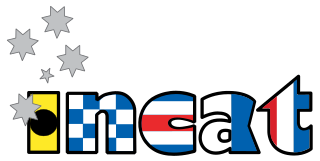
Incat Tasmania is an Australian manufacturer of high-speed craft (HSC) catamaran ferries. Its greatest success has been with large, sea going passenger and vehicle ferries, but it has also built military transports and since 2015 it has built smaller river and bay ferries. Based in Derwent Park, a suburb of Hobart, Tasmania, Australia, it was founded by Bob Clifford.

Amsterdam Centraal station is the largest railway station in Amsterdam, North Holland, the Netherlands. A major international railway hub, it is used by 192,000 passengers a day, making it the second busiest railway station in the country after Utrecht Centraal and the most visited Rijksmonument of the Netherlands.
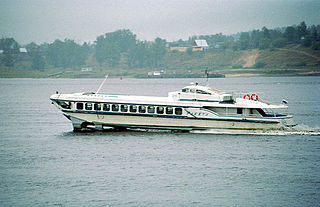
Raketa was the first type of hydrofoil boats commercially produced in the Soviet Union. First planned in the late 1940s as "project 340" by chief designer Rostislav Alexeyev, the vessels were manufactured from 1957 until the early 1970s.

Manly ferry services operate on Sydney Harbour connecting the Sydney suburb of Manly with Circular Quay in the CBD, a journey of seven nautical miles.

A ground-effect vehicle (GEV), also called a wing-in-ground-effect (WIG), ground-effect craft, wingship, flarecraft or ekranoplan, is a vehicle that is able to move over the surface by gaining support from the reactions of the air against the surface of the earth or water. Typically, it is designed to glide over a level surface by making use of ground effect, the aerodynamic interaction between the moving wing and the surface below. Some models can operate over any flat area such as frozen lakes or flat plains similar to a hovercraft.

Dutch railway services is an index page of all the rail services operated in the Netherlands.

"Turya class" is the NATO reporting name for a class of hydrofoil torpedo boats built for the Soviet Navy and Soviet allies. The Soviet designation was Project 206M.
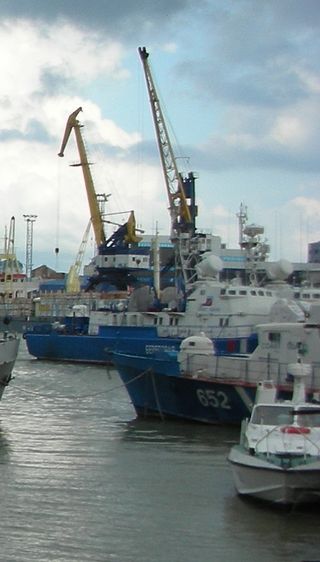
The Muravey-class is the NATO reporting name for a class of hydrofoil patrol boats built for the Soviet Navy between 1983 and 1989. The Soviet designation was Project 133 Antares.
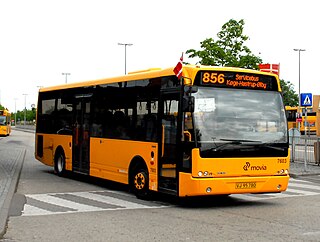
The Berkhof Ambassador is a low-floor city bus produced by the Dutch bus manufacturer VDL Berkhof between 2001 and 2011 when it was replaced by the VDL Citea. The section between the front and rear door are at the same height. The seats at the very rear are a bit higher, and can be reached by using stairs.
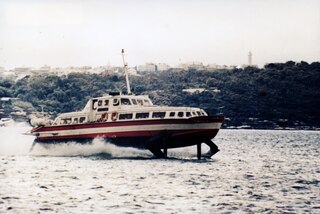
MV Manly was a Supramar PT20 type hydrofoil ferry which operated on Sydney Harbour from 1965 to 1980. It was the first hydrofoil to operate on Sydney Harbour.
The main public transport in the Netherlands for longer distances is by train. Long-distance buses are limited to a few missing railway connections. Regional and local public transport is by bus and in some cities by metro and tram. There are also ferries.

The Sydney JetCats were a class of catamarans operated by the State Transit Authority and Sydney Ferries Corporation on the Manly service.
The Ukrainian shipbuilding industry began to develop in times of the Cossacks.

Sydney Harbour ferry services date back to the first years of Sydney's European settlement. Slow and sporadic boats ran along the Parramatta River from Sydney to Parramatta and served the agricultural settlements in between. By the mid-1830s, speculative ventures established regular services. From the late-nineteenth century the North Shore developed rapidly. A rail connection to Milsons Point took alighting ferry passengers up the North Shore line to Hornsby, New South Wales via North Sydney. Without a bridge connection, increasingly large fleets of steamers serviced the cross harbour routes and in the early twentieth century, Sydney Ferries Limited was the largest ferry operator in the world.














